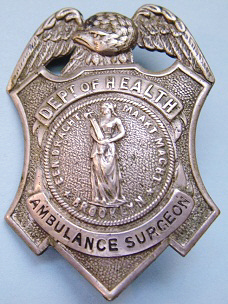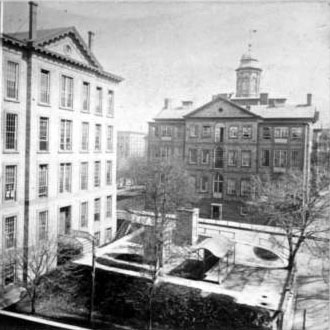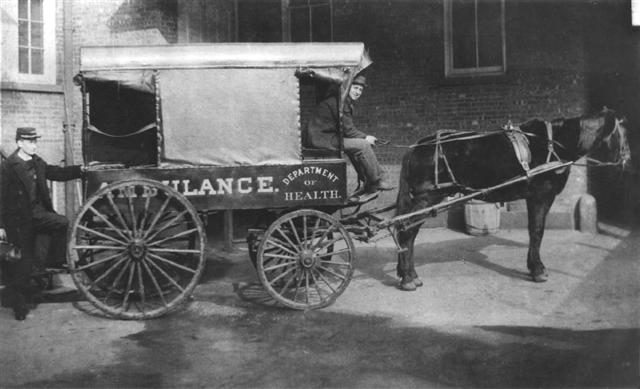
To the Editor of The Brooklyn Daily Union: Sir: I desire to bring to the attention of the public a subject which has for some time occupied my thoughts. No one but an eye witness can begin to comprehend the suffering to which men, women and children are subjected when, after the receipt of an injury, they are carried to the hospital; and to fully appreciate the pain and anguish of these unfortunates as they are hurried over rough streets or handled by unskilled hands, is beyond the power of the most sympathizing and tender hearted. In a city which boasts it is to be the City of Churches, and therefore, the City of Charities, where kindness for the brute creation has induced human beings to devote both time and money to the alleviation of their misfortunes, men are left to suffer indescribable tortures before they can be conveyed to the hospital. He goes on to relate the story of Peter Sherry, a printer run over by a horse in Williamsburg, resulting in near amputation and open fracture of his thigh. “He was taken to a house to wait until a wagon could be found to take him to the hospital.” It took some five hours before a wagon could be located to transport him. “It is unnecessary to add that he died the same day. Had he been sent to the hospital immediately, the bleeding vessels tied, and his strength sustained by stimulants, who shall say that his life might not have been saved?” Dr. Raymond cites several other cases. “The variety of conveyances used to transport these patients to the hospital was as great as the variety of injuries received: carriages, boards, stretchers, and wagons of all description, none but the stretchers being in any way fitted for the purpose... Now for the remedy for this evil and suffering. Let Brooklyn adopt the Ambulance System which in New York has worked so well, and which has saved so many lives.” “I would suggest that there be two ambulances, one stationed at the Long Island College Hospital, Henry, corner of Pacific street, and the other at the Brooklyn City Hospital, on Raymond street. These ambulances should each be in charge of a surgeon” |
 |
Brooklyn City Hospital-built to accommodate 160 patients in the lot
bounded by Raymond Street (now Ashland Place),
Canton Street (now Brooklyn Tech Place), and DeKalb Avenue. |
The Brooklyn Daily Eagle echoed this call in an editorial on November 18, 1871, repeating the cases presented by Dr. Raymond, and calling for an ambulance to be stationed at police headquarters which will be “ in charge of a surgeon, and must always be in readiness.”
“An accident occurring in any part of the city is reported at once to police headquarters by telegraph, and in less time almost than it takes to tell, the patient is seen by the surgeon, his wounds properly attended to, and being placed in the ambulance, is under the supervision of the surgeon, conveyed to the hospital or his house, as he desires.”
On January 8, 1872 , another call for ambulance service is conveyed to the Common Council of the City of Brooklyn.
Gentlemen: At an inquest held in December last, the following verdict was rendered, and recommendation made, viz.: That Adam Hadden came to his death from excessive loss of blood consequent upon injuries received on the 7th instant, by being run over on the South Side railroad, and we believe that had he received immediate surgical attention, his life might have been saved, and we would call attention of the Common Council to the urgent necessity of some method of caring for the injured, and earnestly recommend that ambulances be provided, properly furnished and superintended by competent surgeons.
All of which is most respectfully submitted, L.A.Whitehill, Coroner |
Shortly after, Alderman William Richardson witnessed an unsuccessful attempt to resuscitate a drowning victim in the Gowanus Canal, off the Hamilton Avenue Bridge. He authored a resolution in the Board of Aldermen calling for the Commissioner of Police to prepare a report to the Board detailing the Police Departments’ current inventory of “vehicles of any kind suitable for the transportation of sick or wounded persons, ...stretchers or any substitute therefore for the conveyance of sick, wounded or diseased persons by bearers,
...Implements or articles for the speedy rescue or assistance of persons who may be in danger of drowning; for the recovery of the bodies of drowned persons
...Appliances for the care, resuscitation and restoration of such persons as may be rescued from the water
...and Instruments and appliances for prompt prevention and staunching the flow of blood from wounded persons until surgical assistance is procured for them, or during transportation..” as well as the Commissioners recommendations for equipment needed at the Police Stations.
The Resolution passed the Common Council unanimously on January 8,1872
On January 9,1872 The Brooklyn Daily Union ran another editorial, citing Coroner Whitehill’s inquest findings, and praising the Regents of Long Island College Hospital for their compassionate loan of their vehicles to the nearby police precinct. It noted however, that “only the precincts nearest the hospital building could be assisted in that way.”
“Police Stations should be liberally supplied with ambulances for the quick transportation of the sick or wounded as they are with the implements or articles for the speedy rescue and restoration of persons drowning or bleeding to death. The Common Council should therefore, repair this radical defect in our police system.”
The Regents of Long Island College Hospital issued a letter :
Hon. Daniel Briggs, President of the Board of Police for Brooklyn: Dear Sir- I am instructed by the Board of Regents of the Long Island College Hospital to inform you that hand ambulances can at all times be obtained at this institution by properly authorized parties, for the purpose of conveying the victims of casualities to the hospital... Very Respecfully your obedient servant W.J. Osborne |
The Common Council finally acted on January 29,1872, following submission of a petition signed by some 3,000 citizens. Alderman Richardson offered a resolution approving $5,000 “for the purchase and equipment of at least 5 ambulances.” Alderman Clancy requested the motion be tabled for a week.
Strong support for the ambulance system resolution came to the Council on February 5 from Dr. John Hutchinson, with a 116 member petition from the Kings County Medical Society. The resolution to appropriate $5,000 for an ambulance system passed the Common Council unanimously.
Additional pressure continued to be exerted by both the Eagle, and the Medical Society, which even went so far as to promise they would establish and fund an ambulance system if the authorities failed to act. Support was also voiced by the Board of Police Commissioners, the Board of Fire Commissioners and the Health Department.
APRIL 5, 1873
A year later, and no ambulances have been purchased. The Brooklyn Daily Eagle runs the editorial:
AMBULANCE FOR THE INJURED- A MATTER OF INTEREST TO BROOKLYNITES.
What Became of the $5,000 Raised? This editorial traces the writings and history of the movement to establish an ambulance system, recounting numerous incidents of unnecessary pain and death.
“Dr John T. Conkling, No. 143 Remsen St. said that the whole system of removing casualty cases as we do was outrageous for a city like Brooklyn, or any other city, they were carted off without any attention paid to comfort or safety. Let a sick or maimed horse be found on the street and Bergh’s men* would be on hand immediately with an expressly built apparatus upon which the horse would be placed with gentleness and care, carried to the stables in Williamsburg, with such ease that it would be a perfect comfort to the poor human creatures that are sent jolting over the hard streets. The great need of an ambulance system was simply a plain fact apparent to all, as two and two make four.” |
MAY 12,1873
The Common Council resolves to have the Board of Health report on the best way to appropriate the $5,000. Several days later they instruct Sanitary Inspector J.H. Raymond M.D. to borrow two ambulances from the City of New York, for temporary use until they could build their own. He is unsuccessful.
JULY 12,1873
The Board of Health recommends two ambulances be purchased: “ one to be located at a livery stable near Long Island College Hospital, and the other at a livery stable near the hospital in the Eastern District, the owners of the stables to furnish each an ambulance horse, harness and driver, to be at all hours ready for service. A surgeon at each of the hospitals named above to be ready to accompany ambulance at any time”
Expenditures approved |
Two Ambulances at $600 each..................................... $1,200 The Use of horses, harnesses, and drivers for 12 months, at $180 per month................................... $2,160
Board for the surgeons at the hospital,
each$35 per month...................................................... $840 Expense for connecting hospitals and stables by telegraph................................................................... $300 Outfit, including medicines, stretchers, pocket cases, fracture-boxes, etc. $100 |
|---|
|
Total...........$4,600 |
|---|
On July 21,1873, Brooklyn Mayor Samuel S. Pond certifies that “pursuant to Section... the Laws of 1873, that the interest of the city requires that said ambulance be procured without calling for proposals” and approves the purchase of an ambulance for the Eastern District.
AMBULANCE SERVICE BEGINS IN THE CITY OF BROOKLYN
 |
| Long Island College Hospital Ambulance, 1873 |
AUGUST 20,1873
AMBULANCE #1 starts service at Long Island College Hospital.
Housed in a stable on the north side of Pacific Street, across from the hospital. It is connected by telegraph to the central office of the
Police Department, Fire Department headquarters, and all fire stations and police precincts.
During its first year of service it responds to 133 calls, staffed by Surgeons G.W. Cushing and E.B. Jones.
Dr. William C. Otterson is appointed Chief of Ambulance Service.
OCTOBER, 1873
AMBULANCE #2 begins service at Eastern District Hospital (110 South 3rd Street), responding to 26 calls by years end,
staffed by Surgeons H.C. McLean, T.W. Nadal, F.C. Talcott, and O.J. Hughes, and supervised by Dr. L.E. Preble.
OCTOBER, 1875
An additional reserve ambulance is purchased.
SEPTEMBER 4, 1882
Thomas Edison’s electric company lights the streets of lower Manhattan.
1883
The telegraph system between hospitals and the Fire and Police Departments had been replaced by a new modern marvel, the telephone.
The Brooklyn Bridge opens, accellerating the expansion into the “suburbs”
JANUARY 28, 1898
The consolidation of Greater New York is complete, with the boroughs of Brooklyn, Queens, The Bronx, and Staten Island join to form
The City of New York. Many municipal services merged in the coming year, including the Fire Department.
According to records from 1904, hospitals providing ambulances received the following compensation:
The ambulance at Long Island College Hospital is owned by the Board of Health, which paid $83/ month for livery stable and driver.
Ambulances of Eastern District, St. Mary’s, St. Catherine’s, Methodist, Episcopal, Norwegian, German, and Williamsburg Hospitals are owned by the hospital, and receive $100/month. Brooklyn Hospital supports two ambulances and receives $200/month.
Ambulances at Kings County Hospital, Coney Island Hospital, and Homeopathic Hospital are owned, maintained and operated by the Department of Public Charities.